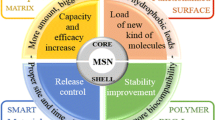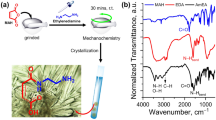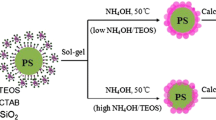Abstract
Recent advances in strategies for synthesizing mesoporous silica particle (MSN) have enabled the precise control of its morphology, size, and composition which afford the applications in drug delivery and heterogeneous catalysis. Especially for drug delivery, the size of MSNs <100 nm is a prerequisite allowing for hemolysis effect. However, a general method for the synthesis of MSNs with uniform size distribution below 100 nm still remains challenging. Herein, a general method was developed to synthesize a family of aqueous colloidal MSNs with uniform size <100 nm using small organic amines (SOAs) or nitrogen-containing heterocyclic compounds (NCHCs) as alkaline catalysts in the presence of cationic quaternary ammonium salts as organic templates. The size of MSNs can be easily adjusted within the range from 28 to 100 nm by the cooperative effect of the mixed alkaline catalysts or using different quaternary ammonium surfactants as templates. Also, texture properties of MSNs including pore diameter and surface area were controlled by selecting different kinds of SOAs or NCHCs. Based on the low refractive index of MSNs, these as-prepared MSNs serve as building blocks and afford an anti-reflective/fogging coating on glass slide through a facile dip-coating method.











Similar content being viewed by others
References
Kresge CT, Leonowicz ME, Roth WJ, Vartuli JC, Beck JS (1992) Ordered mesoporous molecular sieves synthesized by liquid-crystal template mechanism. Nature 359:710–712
Beck JS, Vartuwli JC, Roth WJ, Leonowicz ME, Kresge CT, Schmitt KD, Chu CTW, Olson DH, Sheppard EW, McCullen SB, Higgins JB, Schlenker JL (1992) A new family of mesoporous molecular sieves prepared with liquid crystal templates. J Am Chem Soc 144:10834–10843
Monnier A, Schuth F, Huo Q, Kumar D, Margolese D, Maxwell RS, Stucky GD, Krishnamurty M, Petroff P, Firouzi A, Janicke M, Chmelka BF (1993) Cooperative formation of inorganic-organic interfaces in the synthesis of silicate mesostructures. Science 261:1299–1303
Hou Q, Margolese DI, Ciesla U, Demuth DG, Feng P, Gier TE, Sieger P, Firouzi A, Chmelka BF, Schüth F, Stucky GD (1994) Organization of organic molecules with inorganic molecular species into nanocomposite biphase arrays. Chem Mater 6:1176–1191
Hou Q, Margolese DI, Cielsa U, Feng P, Gier TE, Sieger P, Leon R, Petroff PM, Schiith F, Stucky GD (1994) Generalized synthesis of periodic surfactant/inorganic composite material. Nature 368:317–321
Stephen AB, Prouzet E, Pinnavaiat TJ (1995) Templating of mesoporous molecular sieves by nonionic polyethylene oxide surfactants. Science 269:1242–1244
Tanev PT, Pinnavaia TJ (1995) A neutral templating route to mesoporous molecular sieves. Science 267:865–867
Zhao DY, Feng JL, Huo QS, Melosh N, Fredrickson GH, Chmelka BF, Stucky GD (1998) Triblock copolymer syntheses of mesoporous silica with periodic 50 to 300 angstrom pores. Science 279:548–552
Zhao DY, Huo QS, Feng JL, Chmelka BF, Stucky GD (1998) Nonionic triblock and star diblock copolymer and oligomeric surfactant syntheses of highly ordered, hydrothermally stable, mesoporous silica structures. J Am Chem Soc 120:6024–6036
Hollamby MJ, Borisova D, Brown P, Eastoe J, Grillo I, Shchukin D (2012) Growth of mesoporous silica nanoparticles monitored by time-resolved small-angle neutron scattering. Langmuir 28:4425–4433
Dou J, Zeng HC (2012) Targeted synthesis of silicomolybdic acid (Keggin acid) inside mesoporous silica hollow spheres for Friedel-Crafts alkylation. J Am Chem Soc 134:16235–16246
Niphadkar PS, Chitale SK, Sonar SK, Deshpande SS, Joshi PN, Awate SV (2014) Synthesis, characterization and photocatalytic behavior of TiO2-SiO2 mesoporous composites in hydrogen generation from water splitting. J Mater Sci 49:6383–6391. doi:10.1007/s10853-014-8365-2
Wang HY, Wan Y (2009) Synthesis of ordered mesoporous Pd/carbon catalyst with bimodal pores and its application in water-mediated Ullmann coupling reaction of chlorobenzene. J Mater Sci 44:6553–6562. doi:10.1007/s10853-009-3612-7
de Vos RM, Verwij H (1998) High-selectivity, high-flux silica membranes for gas separation. Science 279:1710–1711
Dong J, Xu ZH, Wang F (2008) Engineering and characterization of mesoporous silica-coated magnetic particles for mercury removal from industrial effluents. Appl Surf Sci 254:3522–3530
Lu F, Wu SH, Hung Y, Mou CY (2009) Size effect on cell uptake in well-suspended, uniform mesoporous silica nanoparticles. Small 5:1408–1413
Lin YS, Haynes CL (2010) Impacts of mesoporous silica nanoparticle size, pore ordering, and pore integrity on hemolytic activity. J Am Chem Soc 132:4834–4842
Townson JL, Lin YS, Agola JO, Carnes EC, Leong HS, Lewis JD, Haynes CL, Brinker CJ (2013) Re-examining the size/charge paradigm: differing in vivo characteristics of size- and charge-matched mesoporous silica nanoparticles. J Am Chem Soc 135:16030–16033
Zhao MW, Gao YN, Zheng LQ, Kang WP, Bai XT, Dong B (2010) Microporous silica hollow microspheres and hollow worm-like materials: a simple method for their synthesis and their application in controlled release. Eur J Inorg Chem 6:975–982
Jeddi K, Sarikhani K, Qazvini NT, Chen P (2014) Stabilizing lithium/sulfur batteries by a composite polymer electrolyte containing mesoporous silica particles. J Power Sources 245:656–662
Hoshikawa Y, Yabe H, Nomura A, Yamaki T, Shimojima A, Okubo T (2010) Mesoporous silica nanoparticles with remarkable stability and dispersibility for antireflective coatings. Chem Mater 22:12–14
Shimizu W, Murakami Y (2010) Microporous silica thin films with low refractive indices and high young’s modulus. ACS Appl Mater Interfaces 2:3128–3133
Grün M, Lauer I, Unger KK (1997) The synthesis of micrometer- and submicrometer-size spheres of ordered mesoporous oxide MCM-41. Adv Mater 9:254–257
Pauwels B, van Tendeloo G, Thoelen C, van Rhijn W, Jacobs PA (2001) Structure determination of spherical MCM-41 particles. Adv Mater 13:1317–1320
Fowler CE, Khushalani D, Lebeau B, Mann S (2001) Nanoscale materials with mesostructured interiors. Adv Mater 13:649–652
Nooney RI, Thirunavukkarasu D, Chen YM, Josephs R, Ostafin AE (2002) Synthesis of nanoscale mesoporous silica spheres with controlled particle size. Chem Mater 14:4721–4728
Lin HP, Tsai CP (2003) Synthesis of mesoporous silica nanoparticles from a low-concentration C(n)TMAX-sodium silicate components. Chem Lett 32:1092–1093
Suzuki K, Ikari K, Imai H (2004) Synthesis of silica nanoparticles having a well-ordered mesostructure using a double surfactant system. J Am Chem Soc 126:462–463
Urata C, Aoyama Y, Tonegawa A, Yamauchi Y, Kuroda K (2009) Dialysis process for the removal of surfactants to form colloidal mesoporous silica nanoparticles. Chem Commun 34:5094–5096
Lin YS, Abadeer N, Hurley KR, Haynes CL (2011) Ultrastable, redispersible, small, and highly organomodified mesoporous silica nanotherapeutics. J Am Chem Soc 133:20444–20457
Wang JZ, Sugawara-Narutaki A, Fukao M, Yokoi T, Shimojima A, Okubo T (2011) Two-phase synthesis of monodisperse silica nanospheres with amines or ammonia catalyst and their controlled self-assembly. ACS Appl Mater Interfaces 3:1538–1544
Wang JZ, Sugawara-Narutaki A, Shimojima A, Okubo T (2012) Biphasic synthesis of colloidal mesoporous silica nanoparticles using primary amine catalysts. J Colloid Interf Sci 385:41–47
Yamada H, Urata C, Aoyama Y, Osada S, Yamauchi Y, Kuroda K (2012) Preparation of colloidal mesoporous silica nanoparticles with different diameters and their unique degradation behavior in static aqueous systems. Chem Mater 24:1462–1471
Yamada H, Urata C, Higashitamori S, Aoyama Y, Yamauchi Y, Kuroda K (2014) Critical roles of cationic surfactants in the preparation of colloidal mesostructured silica nanoparticles: control of mesostructure, particle size, and dispersion. ACS Appl Mater Interfaces 6:3491–3500
Yano K, Fukushima Y (2003) Particle size control of mono-dispersed super-microporous silica spheres. J Mater Chem 13:2577–2581. doi:10.1016/j.micromeso.2006.02.013
Fukushima Y, Yano K (2006) Synthesis of monodispersed super-microporous/mesoporous silica spheres with diameters in the low submicron range. Micropor Mesopor Mat 93:190–198
Möller K, Kobler J, Bein T (2007) Colloidal suspensions of nanometer-sized mesoporous silica. Adv Funct Mater 17:605–612
Kobler J, Möller K, Bein T (2008) Colloidal suspensions of functionalized mesoporous silica nanoparticles. ACS Nano 2:791–799
Jansen JC, Shan Z, Marchese L, Zhou W, Puil NVD, Maschmeyer T (2001) A new templating method for three-dimensional mesopore networks. Chem Commun 8:713–714
Haskouri JEI, de Zárate DO, Guillem C, Beltrán-Porter A, Caldés M, Marcos MD, Beltrán-Porter D, Julio L, Amorós P (2002) Hierarchical Porous Nanosized Organosilicas. Chem Mater 14:4502–4504
Lin YS, Hurley KR, Haynes CL (2012) Critical considerations in the biomedical use of mesoporous silica nanoparticles. J Phys Chem Lett 3:364–374
Pan LM, He QJ, Liu JN, Chen Y, Ma M, Zhang LL, Shi JL (2012) Nuclear-targeted drug delivery of TAT peptide-conjugated monodisperse mesoporous silica nanoparticles. J Am Chem Soc 134:5722–5725
Zhang Q, Wang XL, Li PZ, Nguyen KT, Wang XJ, Luo Z, Zhang HC, Tan NS, Zhao YL (2014) Biocompatible, uniform, and redispersible mesoporous silica nanoparticles for cancer-targeted drug delivery in vivo. Adv Funct Mater 24:2450–2461
Zhang K, Xu LL, Jiang JG, Calin N, Lam KF, Zhang SJ, Wu HH, Wu GD, Albela B, Bonneviot L, Wu P (2013) Facile large-scale synthesis of monodisperse mesoporous silica nanospheres with tunable pore structure. J Am Chem Soc 135:2427–2430
Qiao ZA, Zhang L, Guo MY, Liu YL, Huo QS (2009) Synthesis of mesoporous silica nanoparticles via controlled hydrolysis and condensation of silicon alkoxide. Chem Mater 21:3823–3829
Chiang YD, Lian HY, Leo SY, Wang SG, Yamauchi Y, Wu KCW (2011) Controlling particle size and structural properties of mesoporous silica nanoparticles using the Taguchi method. J Phys Chem C 115:13158–13165
Valtchev V, Tosheva L (2013) Porous nanosized particles: preparation, properties, and applications. Chem Rev 113:6734–6760
Thanh NTK, Maclean N, Mahiddine S (2014) Mechanisms of nucleation and growth of nanoparticles in solution. Chem Rev 114:7610–7630
Carcouët CCMC, van de Put MWP, Mezari B, Magusin PCMM, Laven J, Bomans PHH, Friedrich H, Esteves ACC, Sommerdijk NAJM, van Benthem RATM, de With G (2014) Nucleation and growth of monodisperse silica nanoparticles. Nano Lett 14:1433–1438
Yokoi T, Wakabayashi J, Otsuka Y, Fan W, Iwama M, Watanabe R, Aramaki K, Shimojima A, Tatsumi T, Okubo T (2009) Mechanism of formation of uniform-sized silica nanospheres catalyzed by basic amino acids. Chem Mater 21:3719–3729
Iler RK (1978) The chemistry of silica. Wiley, New York
Ryoo R, Park IS, Jun S, Lee CW, Kruk M, Jaroniec M (2001) Synthesis of ordered and disordered silicas with uniform pores on the border between micropore and mesopore regions using short double-chain surfactants. J Am Chem Soc 123:1650–1657
Li XY, Shi B, Wang YJ, Li MM, Liu Y, Gao L, Mao LQ (2015) Preparation of monodispersed mesoporous silica particles and their applications in adsorption of Au3+ and Hg2+ after mercapto-functionalized treatment. Micropor Mesopor Mat 214:15–22
Yi ZF, Dumée LF, Garvey CJ, Feng CF, She FH, Rookes JE, Mudie S, Cahill DM, Kong LX (2015) A New Insight into Growth Mechanism and Kinetics of Mesoporous Silica Nanoparticles by in Situ Small Angle X-Ray Scattering. Langmuir 31:8478–8487
Yokoi T, Sakamoto Y, Terasaki O, Kubota Y, Okubo T, Tatsumi T (2006) Periodic arrangement of silica nanospheres assisted by amino acids. J Am Chem Soc 128:13664–13665
Guo CC, Holland GP (2014) Investigating lysine adsorption on fumed silica nanoparticles. J Phys Chem C 118:25792–25801
Li XY, Du X, He JH (2010) Self-cleaning antireflective coatings assembled from peculiar mesoporous silica nanoparticles. Langmuir 26:13528–13534
Cho JH, Hong JK, Char K, Caruso F (2006) Nanoporous block copolymer micelle/micelle multilayer films with dual optical properties. J Am Chem Soc 128:9935–9942
Li XY, He JH (2013) Synthesis of raspberry-like SiO2-TiO2 nanoparticles toward antireflective and self-cleaning coatings. ACS Appl Mater Interfaces 5:5282–5290
Bico J, Tordeux C, Quéré D (2001) Rough wetting. Europhys Lett 52:214–220
Courbin L, Denieul E, Dressaire E, Roper M, Ajdari A, Stone HA (2007) Imbibition by polygonal spreading on microdecorated surfaces. Nat Mater 6:661–664
Acknowledgements
The authors are grateful to the financial aid from the National Natural Science Foundation of China (Grant No. 21104016).
Author information
Authors and Affiliations
Corresponding author
Electronic supplementary material
Below is the link to the electronic supplementary material.
Rights and permissions
About this article
Cite this article
Li, X., Shi, B., Chaikittisilp, W. et al. A general method to synthesize a family of mesoporous silica nanoparticles less than 100 nm and their applications in anti-reflective/fogging coating. J Mater Sci 51, 6192–6206 (2016). https://doi.org/10.1007/s10853-016-9916-5
Received:
Accepted:
Published:
Issue Date:
DOI: https://doi.org/10.1007/s10853-016-9916-5




